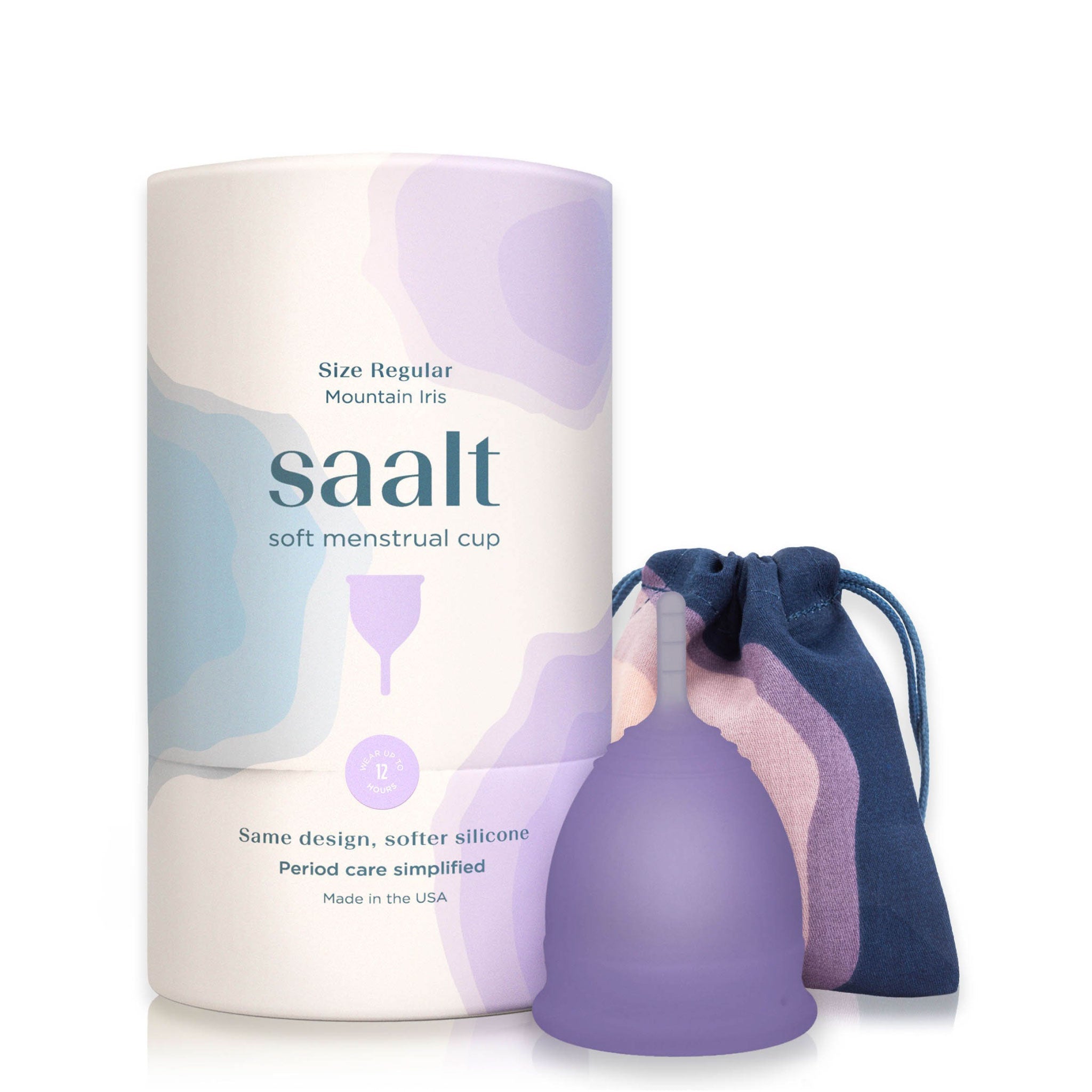What do menstrual discs do? How do menstrual discs work?
A menstrual disc is worn internally like a tampon, but collects rather than absorbs your period flow. Menstrual discs sit in the vaginal fornix and are held in place by their rim, so you can comfortably hike, swim, and even have sex with your disc inserted.
Can a menstrual disc get stuck?
The Saalt Disc’s custom removal notch sets it apart from most reusable and disposable menstrual discs, making it specially designed to help make removal even easier.
If disc removal is ever difficult, the most important thing to remember is to relax! If you have been laying down or have had sex with the disc in, spend 30 minutes upright and walking around before removal to allow gravity to move the disc lower.
Will my partner feel my menstrual disc during sex?
Because most reusable menstrual discs are made of soft material such as medical-grade silicone, many people have reported not being able to feel them during intercourse. Learn more about the benefits of period sex.
What is the down side of a menstrual disc?
While many people can wear menstrual discs comfortably, they are not one size fits all. Most brands offer a single size, but Saalt retails menstrual discs in two sizes; the Saalt Regular Disc, similar in size to most other menstrual disc brands, and the Saalt Small Disc, which is perfect for those who have had trouble with one-size discs being too large.
Can you sleep with a menstrual disc in?
Yes! Because menstrual discs, like menstrual cups, can be worn for up to 12 hours, it’s safe to wear it overnight. For extra peace of mind at night, consider pairing your disc with leakproof underwear like period panties.
How does a menstrual disc self-empty or auto-dump?
Self-emptying (also known as “auto-dumping”) occurs when the pelvic floor muscles contract, causing the rim of the disc to momentarily move out of place and spill some of its contents. The rim will move back to its original position when the pelvic floor muscles relax. Many people enjoy this feature because it allows them to empty their disc without removing it.
How do I know when to empty my menstrual disc?
Most menstrual discs are safe to wear for up to 12 hours. Because discs often have a higher capacity than tampons, pads, and even period cups, you may find you can wear your disc for the entire 12 hour span before needing to empty. However, you may need to empty it a little more often than that on your heavier days. Wearing a back up liner or period underwear for extra protection as you learn your flow is a great idea. After a few periods you’ll have a better understanding of your flow and how often you’ll need to empty your menstrual disc.
Why is my menstrual disc leaking?
Leaking with a reusable menstrual disc is often a sign that it’s not positioned correctly under the cervix, overfilling, or self-emptying.
To ensure that the disc is positioned under the cervix, check the position of your cervix before inserting the disc. Then, insert the disc at a horizontal angle toward your tailbone. To make sure your cervix is completely covered, slide your index finger beneath the basin. Then, feel around the rim of the disc to make sure your cervix is not sitting outside of it.
If the disc is overfilling, you can self-empty it when using the restroom to empty some of the contents. You may also need a disc with a larger capacity or you may need to remove and empty the disc more often on your heavy days.
If you prefer to prevent self-emptying when using the restroom, prop your feet on a stool to raise your knees above your hips to relax the pelvic muscles and prevent them from squeezing the disc and releasing the contents.
How do I know my menstrual disc is in correctly?
When a menstrual disc is inserted correctly, it will be comfortable, leak-free, and will stay in place. If your disc causes discomfort, leaks, or slips out of place, it most likely is not in the correct position. It’s normal for the disc to form to your shape, so if it feels like the basin isn’t fully opened, that’s perfectly normal.
How far in does a menstrual disc go?
Menstrual discs are inserted in the vaginal canal below the cervix, typically about the length of a finger or less. A menstrual disc sit a little higher in the vaginal canal than a menstrual cup.
What's the difference between a menstrual cup and menstrual disc?
Menstrual cups sit lower in the vaginal canal than a tampon would, whereas menstrual discs are held in place by their rim in the vaginal fornix (aka the wider space around the cervix). Most menstrual cups stay in place by forming a seal. One unique feature about the menstrual disc is that it can be worn during penetrative sex while reusable menstrual cups must be removed before sex.
Most people can use either a cup or a disc, so it’s ultimately personal preference. You may find that you like switching between a period cup or a disc throughout your period, or you may stick to just one.
While most people can use either product, you may prefer a menstrual disc if you have a low cervix or weakened pelvic floor. You may prefer a menstrual cup if you have a more active lifestyle or a higher cervix.
Learn: menstrual cup vs. disc
Do doctors recommend menstrual discs?
Gynecologists agree that reusable menstrual cups and discs are a safe and effective longterm sustainable option for both your body and the planet. A peer-reviewed study published in BMJ Sexual & Reproductive Health analyzed 21 menstrual hygiene products - including tampons, pads, menstrual cups, and menstrual discs - using expired human red blood cells to evaluate true absorption capacity. Researchers found that menstrual discs help the most blood, with an average capacity of 61mL.
Key point from the research:
- Menstrual discs outperformed tampons, pads, and cups in terms of capacity
- Dr. Paul Blumenthal, MD and colleagues noted this evidence suggests discs may be ideal for managing heavy flows and helping clinicians better assess menstrual blood loss.
Dr. Jessica Shepherd, obstetrician-gynecologist and chief medical officer at Verywell Health, says discs are "absolutely" a healthy menstrual tool in an article posted on USA Today online August 6, 2021 entitled ‘You’ve heard about the menstrual cup, but what about the menstrual disc?’
"Alternatives like cups and discs... are great ways for people to have options that are not necessarily in the pad or tampon range," she says.
If you’re wondering about the use of menstrual cups or discs with IUDs, read what a medical professional has to say in Can You Use a Menstrual Cup or Disc with an IUD? Additionally, an infectious disease expert shares some great information regarding the risk of TSS with menstrual cups or discs in TSS: What You Need to Know and How to Prevent It. If you have questions as to whether or not a menstrual disc would be a good option for you, reach out to your physician.
If you are ready to make the switch, check out our Saalt Disc Duo and get your disc journey going today!
Sources:
- BMJ Group. (2023, July 8) Menstrual discs may be best for heavy monthly blood flow. https://bmjgroup.com/menstrual-discs-may-be-best-for-heavy-monthly-blood-flow/
- USA Today. (2021, August 6) You've heard of a menstrual cup, but what about a menstrual disc? https://www.usatoday.com/story/life/health-wellness/2021/08/06/menstrual-discs-what-they-they-different-tampons-cups/5485712001/
tags: Menstrual Discs, What You Should Know About Menstrual Discs -- Saalt,








